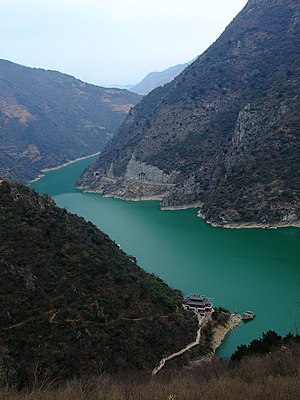Way of the Five Pecks of Rice

The Way of the Five Pecks of Rice (Chinese: 五斗米道; pinyin: Wǔ Dǒu Mǐ Dào) or the Way of the Celestial Master, commonly abbreviated to simply The Celestial Masters, was a Chinese Taoist movement founded by the first Celestial Master Zhang Daoling in 142 CE. At its height, the movement controlled a theocratic state in the Hanzhong valley, north of Sichuan. In 215 CE, the state was incorporated into Cao Cao’s Kingdom of Wei, and the followers of the Celestial Master were dispersed all over China.
The Celestial Masters believed that qi pervaded everything, and in order to achieve immortality, the correct balance of qi had to be present within the body. Having a poor quantity of qi in the body, would result in illness, and eventually death. Meditation could be used to restore qi to the body, but sex was to be avoided, as it could result in the loss of qi. If there was the correct balance of qi within the body upon death, an adherent could ‘feign death’ and be reborn. If not, an adherent would be transported to an earthly prison where he would face eternal torment.
The Hanzhong state was divided into 24 regions which were led by an official. Each district had a civil register which recorded people’s names and ranks. Three times a year, the registers were updated at the same time as an important feast. While a child’s rank rose automatically, adults had to raise their own rank through religious achievement or marriage. Higher ranked people had more divine generals at their command, which could be used to fight demons that caused bad luck or disease. The state had a system of law that encouraged confession and benevolence rather than strict punishment. Criminals were asked to confess their crimes and meditate, and were given public work to do as a sentence. Few texts written by the Hanzhong Celestial Masters survive, with the most important being the Xiang’er commentary to the Dao De Jing. While the Hanzhong state lasted for only twenty-five years, their beliefs influenced all subsequent Daoist movements.
In 142 CE Zhang Daoling announced that Laozi had appeared to him and commanded him to rid the world of decadence and establish a new state consisting only of the ‘chosen people.’ Zhang became the first Celestial Master, and began to spread his newly founded movement throughout the province of Sichuan.[1] The movement was initially called the Way of the Five Pecks of Rice, because each person wishing to join was required to donate five pecks of rice (actually five dǒu, equal to 13.6 US gallons or 5.9 pecks).[2] The movement spread rapidly, particularly under his son Zhang Heng (張衡) and grandson Zhang Lu.[3] The Zhangs were able to convert many groups to their cause, such as the Bandun Man (belonging to the Ba people), which strengthened their movement.[4] In 184, Zhang Xiu(張脩, not related to Zhang Lu) rebelled against the Han Dynasty. In 191, Zhang Lu and Zhang Xiu were sent to conquer the Hanzhong valley, just north of Sichuan, which was under Su Gu’s c (蘇固)ontrol.[5] During the subsequent battle, Zhang Xiu was killed, and Zhang Lu founded the theocratic state of Zhanghan, enjoying full independence.[3][6]
In 215, Cao Cao, the ruler of the Kingdom of Wei attacked the Hanzhong state, and forced Zhang Lu to flee to Eastern Sichuan, where he later surrendered.[7] Zhang was given a title and land, as were several other family members and generals.[8] His followers were forced to resettle in other parts of China, with one group being sent to the Chang’an area, and another being sent to Luoyang. Zhang and his family relocated to Cao Cao’s administrative headquarters in Ye, located in today’s Hebei and Henan provinces.[9] He then used his own popularity as a religious leader to lend legitimacy to the Wei, proclaiming that the Wei court had inherited divine authority from the Daoist church, as well as from Confucian laws. Shortly after the surrender, Zhang Lu died and was succeeded by his son, Fu. After this point there are few historical sources until 255 CE, when a text indicates that the Celestial Master community was fragmenting as a result of the political turmoil within the Wei Kingdom[10][11]
The collapse of the Kingdom of Wei in 260 CE, along with the fall of Northern China to the Huns in 317, further scattered adherents to the Celestial Master.[12] The Celestial Masters later reemerged in the 4th and 5th centuries as two distinct offshoots, the Northern and Southern Celestial Masters.[13]
